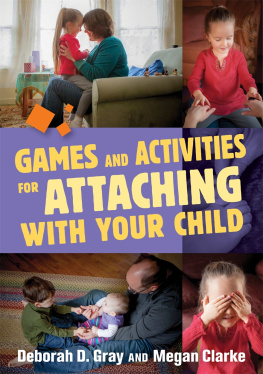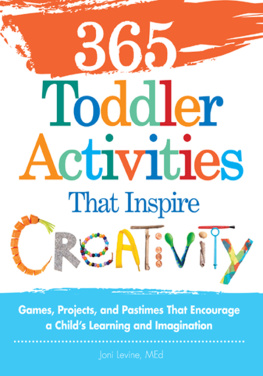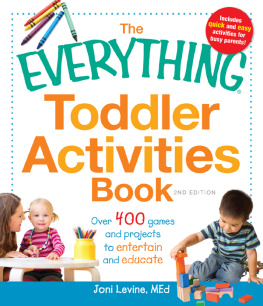Dedication
For my dear friends Jackie, Janine, and Kimberly, who keep me moving on even the darkest, rainiest days. Youve helped me discover that a child who grew up believing one should be either smart or athletic can become an adult who is both!
Contents
Introduction
When I began writing The Fitness Fun Busy Book, I thought it would be like the other books in my Busy Book series. I designed those books to help parents and caregivers cope with the demands of toddlers and preschoolers (and their short attention spans); keep kids busy with creative games and activities; and give parents and caregivers simple, straightforward ideas that dont require major organization or cleanup.
While writing this book, however, I discovered some alarming statistics. In the past thirty years childhood obesity has more than doubled in children, and tripled in adolescents. In 2010 more than one-third of children and adolescents were overweight or obese. And the increase in childhood obesity rates is not just a North American problem. Obesity, diabetes, and heart diseaseonce thought to be diseases of the wealthyare spreading to developing countries. Poor diet and inactivity are now global problems.
With the rise in childhood obesity comes a growing awareness of the importance of establishing healthy lifestyle habits early in life. In 2010 First Lady Michelle Obama launched the Lets Move initiative which is dedicated to solving the challenge of childhood obesity within a generation. At the launch Mrs. Obama stated, The physical and emotional health of an entire generation and the economic health and security of our nation is at stake. Other programs, such as the NFLs Play 60 and Canadas Bring Back Play, encourage todays youth to be active for at least sixty minutes a day.
Clearly, this book isnt just for parents who want ideas on how to channel their overactive childrens energy. Because research has shown that increasing physical activity and fitness levels in early childhood is essential for the health and well-being of the next generation, this book is for parents and caregivers of toddlers and preschoolers of every shape, size, and energy level. Our attitudes toward exercise and fitness take shape early in life, and parents and caregivers of toddlers and preschoolers are in the best position to ensure that children lead healthy, active lifestyles and learn the importance of physical fitness.
In fact, this book may not even make parents lives simpler, as I hope my previous books have done. I know that it sometimes seems easier for todays busy parents and caregivers to let their young ones watch TV, play computer games, or otherwise keep themselves occupied with sedentary activities. But kids need to move! Kids who are active develop physical skills that contribute to cognitive, social, and emotional development. Kids who are active perceive themselves to be competent, and kids who feel good about their physical abilities are more likely to participate in activities necessary to improve health and fitness.
Many parents worry that theyre not qualified to teach their kids physical skills; that unless children are taught to move the right way, theyll be at a disadvantage. Of course thats not true! Certainly teachers and coaches who wish to teach a particular skill must focus on proper technique, but parents and caregivers dont need to be experts in order to teach their children the importance of physical activity. Teaching children to enjoy being active is so much more important than knowing the right techniques. Keep in mind that kids who are active throughout their preschool yearseven without formal training in movement skillswill have an advantage over those whove spent a majority of their time doing sedentary activities. Ive designed the ideas in The Fitness Fun Busy Book with this fact in mind, and Ive made it easy for you and your child to have fun and be active together.
While the ideas in this book are great for getting adults to be active with their children, they wont do much to get most adults in shape. If you lead a fairly sedentary life yourself and wonder if youve got what it takes to raise an active child, know that its never too late to get physically fit. Several years past my fortieth birthday, I discovered the joy of being active. I started out taking long walks and short runs and eventually graduated to five- to ten-mile runs three or four times a week. I recently ran a half marathon, and I hope to have a full marathon under my belt by the time this book is published. Im not an elite athlete by any stretch of the imaginationjust an average middle-age mom who has learned to love the exhilaration of pushing myself beyond what I think I can do.
Some ideas in The Fitness Fun Busy Book appear in other books Ive written, and Ive included them to provide the best physical activities and games for young children in one volume. Ive organized the activities by chapter, but many of them can fit into two or more chapters. For example, many indoor activities make great outdoor activities, and a few seasonal materials can easily turn creative movement activities into indoor holiday games.
The abilities of toddlers and preschoolers vary greatly, so some ideas in this book will be too advanced for a young toddler, while others will be too simple for an older preschooler. Because a childs development often isnt related to age, I dont suggest ages for most of the activities. Choose activities that best meet your childs capabilities and interests. If a new activity doesnt go over well, dont write it off altogether. Try it again later, or vary the activity to make it more meaningful and interesting for your child.
My hope for The Fitness Fun Busy Book is that itll help children (and the adults who love them) learn to love physical activity and become fit for life. Whether you already lead an active lifestyle or are just beginning to head in that direction, my wish is that this book will give you the right combination of motivation, information, and ideas to help you raise a child who is healthy, strong, flexible, and on the road to lifelong fitness. If you have any questions or comments about this book, you can e-mail me or write to me in care of Meadowbrook Press. Id love to hear from you.

P.S. In recognition of the fact that children do indeed come in both sexes, and in an effort to represent each, the use of masculine and feminine pronouns will alternate with each chapter.
Chapter 1
Get Moving!
Mama exhorted her children at every opportunity to jump at de sun. We might not land on the sun, but at least we would get off the ground.
Zora Neale Hurston
Children are born to move! Watch your toddler for a moment or two, and her boundless energy will amaze you. Whether shes eating, playing, singing, bathing, or listening to a story or song, shell likely be squirming and fidgeting, making sure shes not missing anything thats happening around her. While preschoolers usually have slightly longer attention spans, they also have lots of energy, often making their parents wish theyd sit still for a while!
But if children are born to move, why are more and more of them growing up without the proper strength and physical development to take on new learning challenges? Why are our children at risk for serious health problems, such as high cholesterol and high blood pressure, prediabetes, and bone and joint problems? Why are children growing up with social and psychological problems, such as stigmatization and poor self-esteem? Take a look at the increase of overweight and obesity in todays children and youth: While in the 1970s only about five percent of children and youth were classified as obese, by 2010 that rate had risen to eighteen percent. Today more than one-third of children and adolescents can be considered overweight or obese.







